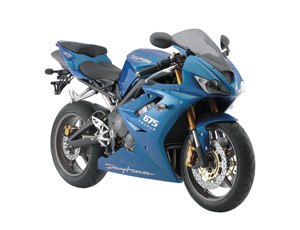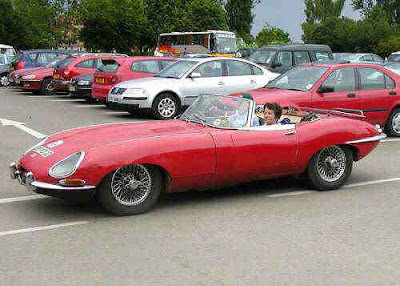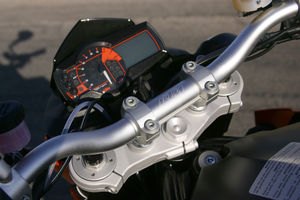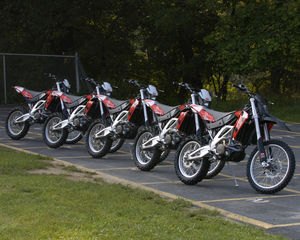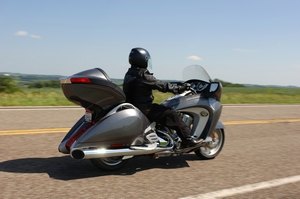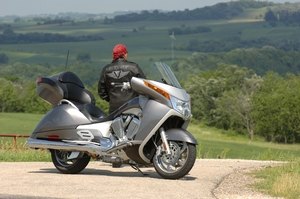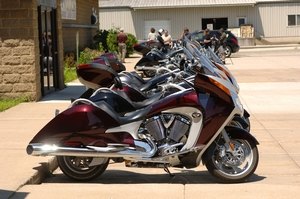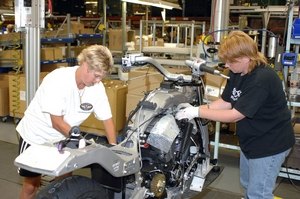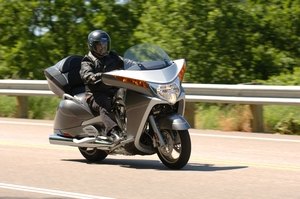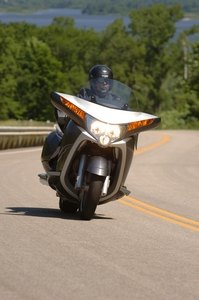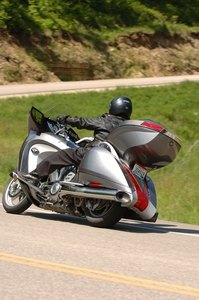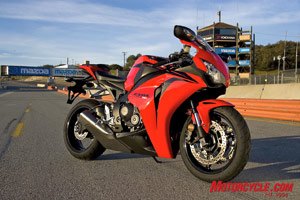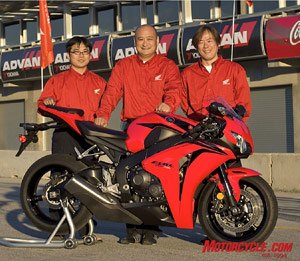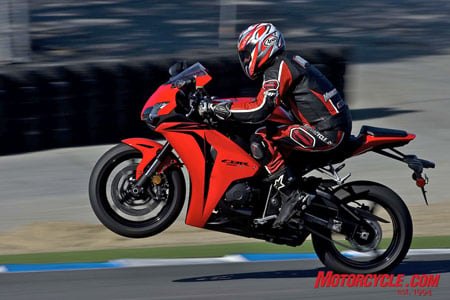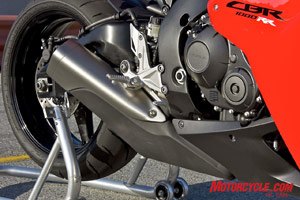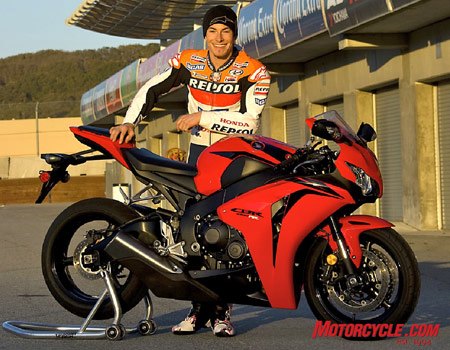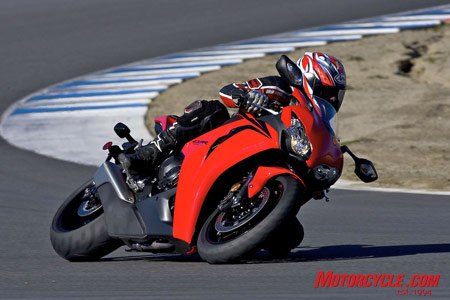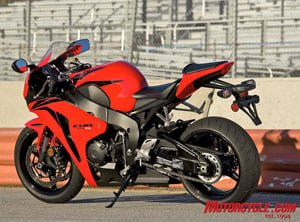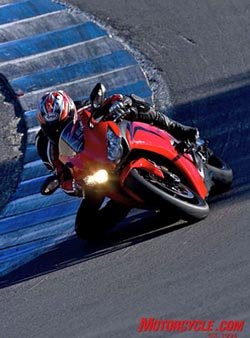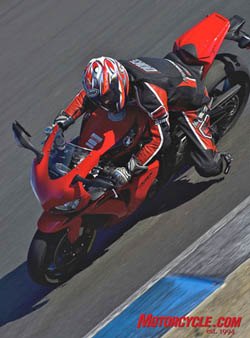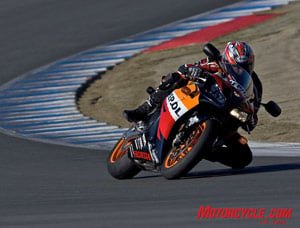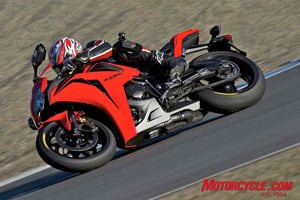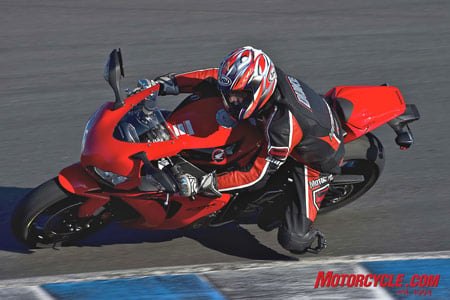By Gabe Ets-Hokin, Senior Editor, Feb. 15, 2007, Photography by Joe Bonello
KTM. If you haven't heard the name, you've still probably seen the bright-orange blur of one of their products anywhere there's an off-road motorcycling event in the world. KTM has grown from an obscure maker of 100cc tiddlers to a dominant force in off-road competition, offering a wide array of enduro, moto-cross, Supermoto and other machines of all different displacements, from 65cc junior bikes to hulking 999cc adventure-enduros. This year -- 2007 -- marks a huge step in the history of the 54 year-old Austrian company. They're getting into the vast US street market by expanding their dual-sport and Supermoto offerings and by introducing a few all-new models, including the 2007 990 Superduke. And to tell the world about it, they wisely invited Motorcycle.com to test it out on our home track, the Streets of Willows in scenic Rosamond, CA, the only town in California that somehow manages to be more horrible than Bakersfield*.
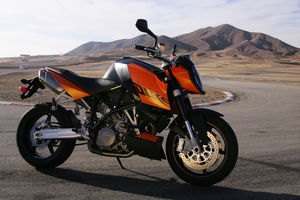
You want one, don't you? Yes, you do.
KTM claims everything they make is "Ready to Race", but how does that equate to a product that is first and foremost a streetbike? Be patient, read on, and you will find out; plus you will find out all about the new 690 Supermoto and the 990 Adventure.
If you've enjoyed our new "Scotch Watch" feature (nominated for a 2006 MotoWeb Best Feature award**) I am sorry to disappoint you: KTM is a no-nonsense company that is all about riding and racing; no fancy dinners or cocktail receptions for the US press. We did enjoy a stunt show courtesy of KTM stunt rider Oliver Ronzheimer and some nice gifts from KTM's stylish accessory catalog before KTM's media relations and design people told us about their new product lineup.
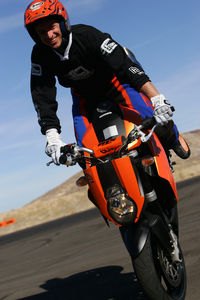
This is what a professional rider on a closed circuit really looks like. KTM stunt rider Oliver Ronzheimer shows off.
The big news is KTM's all-new 990 Superduke. KTM's designers wanted KTM's entry into the naked roadster market to have a "special, unique appearance," and their insectoid***-inspired vision has that, in spades. With sharp creases, bold colors, minimal bodywork and cool touches like the truncated exhausts and tiny "wind spoiler" mounted above the tiny instrument display, this KTM will get plenty of attention, even parked next to a wild custom chopper.
Plastic shrouds that look like they came off a giant motocrosser cover a 999.9cc liquid-cooled, DOHC four-valve V-twin motor that is extremely compact and lightweight thanks to its 75-degree V-angle and dry-sump design. A counterbalancer keeps things smooth. Fueling is by Kehin EFI, and the twin exhausts are catalyzed and have integrated heat shields, all neatly tucked up into the bike's abbreviated tailsection. Power output is around 120hp at the crank.
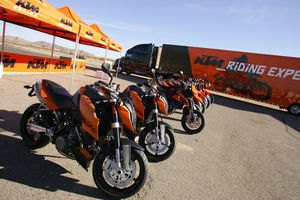
If this looks good to you, follow the big orange truck to a motorcycling event near you for some test-riding fun. Check http://www.ktmusa.com for more information.
The motor goes into a chrome-moly trellis frame that is not only nice to look at, it's also about as light and rigid as a frame can be. Suspension is race-ready WP components, with a 48mm fully-adjustable upside-down cartridge fork and fully-adjustable linkage-less rear shock. The suspension is much more street-oriented, with two inches less wheel travel than the 950 Supermoto's. Tires are the grippy, proven Dunlop D208, with a 120/70-17 in front and a 180/55-17 in the back. Wheelbase is a stylishly short 56.6 inches, rake is a steep 23.5 degrees, and KTM claims the dry weight is only 406 pounds.
|
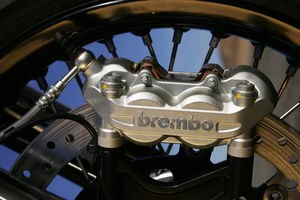 In 20 years these brakes will be on a middleweight cruiser. |
To complete the package, there is a matte-finished 4.8-gallon plastic tank and a programmable instrument display. There's also a minimal seat with passenger pegs, and besides what might be the smallest windscreen on a motorcycle ever, there's not much else, really. The only component of this bike that isn't pared-down to the bare essentials is the price tag; $13,998.
Also a big deal was the all-new 690 Supermoto. The media people didn't know if the bike would arrive in time, as they were held up in customs, but at the last minute a truck arrived at the track with a small fleet of the new thumpers for us to sample.
This bike is a purpose-built streetbike, not a dirtbike with a wheel kit like many Supermotos. The frame is a trellis unit, with a huge space for an airbox and a distinctive cast-aluminum ribbed swingarm. Front suspension is the same fully-adjustable 48mm upside-down unit on the 990 Superduke, but with more travel. Wheels are spoked jobs, with Behr aluminum rims and Bridgestone BT-090 European-market street Supermoto tires, a 120/70-17 in front and a 160/60-17 in the back. Rear suspension is a fully-adjustable monoshock with a KTM "Pro-Lever" linkage.
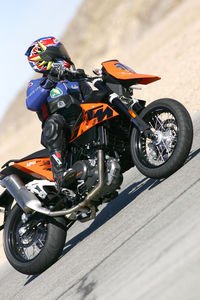
Gabe contemplating a trip into the dirt.
The motor is as new as the rest of the bike. The new LC4 engine is a fuel-injected SOHC four-valve, liquid-cooled, counterbalanced 653.7cc four-stroke single with an all-new six-speed transmission and "Alder Power Torque" slipper clutch. Catalyzed exhaust enters the atmosphere via a pair of huge, vertically-mounted mufflers that look like they came off a semi-truck (but are actually similar to what KTM uses on their race thumpers). "KTM should offer some of those little flappers to put over the tips so they go ?lank-clank-clank' at idle," I helpfully offered to a KTM person. "Ha, ha," they responded, unconvincingly. It's all good for a claimed 63hp at the crank; look for about 54hp at the back wheel.
The bike is finished as minimally as you'd expect. There's a 3.7-gallon fuel tank, an all-new instrument cluster similar to the Superduke's, tapered aluminum handlebars, a dagger-shaped headlamp/fender unit, a tiny storage compartment under the seat, and an LED tail lamp. At press time, KTM didn't have a price, but expect it to be in the $7,000-$9,000 price range.
The other notable machine was the revised fuel-injected 990 Adventure/Adventure S. It uses the same 999.9cc motor as the 990 Superduke, but with shorter gearing (both the internal gear ratios as well as final drive) and tuned for more midrange. The chassis is also similar, with 48mm USD forks and rear monoshock; however, the wheelbase is five inches longer than the Superduke and the bike weighs in at 456.4 pounds (claimed, dry). Along with the fuel injection there's also a high-tech ABS system standard that weighs but three pounds (even though claimed weight overall is up 20 pounds compared to the 950 Adventure) and is easily deactivated by a dashboard switch. Pricing is $13,998, and an extra 200 bucks gets you the ?' model with blacked-out cosmetics.
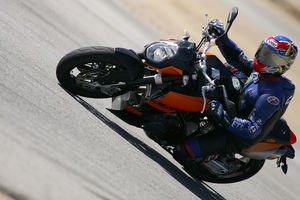
After 40 minutes of tech briefings we're eager to ride these bikes, so as soon as it ends there's a comical race to change into leathers and dash outside to grab one of the six Superdukes available to ride. I'm able to get onto one in time, and I note the manageable (but still high) seat height and very comfortable ergonomics; the pegs aren't too far back or high, and the tapered bar puts me in a slight forward lean. The motor fires easily, with little vibration and a light feel from what must be a small, light flywheel. The exhaust note is distinctive, with a sharp, mechanical flatness that sounds mean as hell. I click into first and head for The Streets' front straight.
I was expecting it to feel like a modified version of the 950 Supermoto I rode last year, but trust me, this is no Supermoto. The motor revs to redline quickly, with power and torque in every gear, yet it is almost fussy in its precise power delivery, making it difficult to modulate power in very tight, slow corners. This is compounded by the much taller gearing of the Superduke, but give it some open road and the light, free-flowing nature of the powerband leaves no doubt; this is a very fast bike, with a motor perfectly suited to a naked roadster.
The suspension is as good as the motor, reacting well to The Streets' heinously bumpy, pot-holed surface. Unlike many factories, KTM buys race-spec suspension and other components, which offer more capability and range of adjustment than more consumer-oriented equipment. This means that a small change in preload or damping settings will make an actual difference in suspension action, so you should know what you're doing before making adjustments. Do you need this kind of adjustability? If so, the WP suspension will reward your knowledge and ability. The brakes are also amazing, with incredibly immediate power, bite and feel. I seldom needed more than half-a-finger to slow, and there was no perceptible change in braking power, even after the bikes had been flogged by the world's top moto-journalists all day long. The riding position gives you a choice of riding styles.
You can ride it either Supermoto/dirt-track style, staying in the seat and pushing the bike down and away from you in turns, or by hanging off and dragging a knee like a roadracer. Either way, the Superduke turns with a linear, precise feel that while not lightning-quick, is still as fast as you need, which indicates exhaustive chassis development to me. As the day continued the 990 stuffed me full of confidence, with the Dunlop D208 tires never slipping or loosing feel, and I started to go faster and faster as I slowly regained my hibernating racetrack mojo.

This might be the fastest thing with a rack, short of Marion Jones.
There were still two new bikes to try -- will this living hell ever end? -- so I rode the new 990 Adventure next. Riding this bike on a racetrack was surprisingly fun, feeling surprisingly similar to the 950 Supermoto, which I also was able to ride. The main differences are the more-comfortable seat, less power (although it still gets up to 100 mph in a hurry) and heavy-feeling steering from the narrow 21-inch front tire and longer wheelbase. Still, this bike was stable -- with a minimum of pogo effect from the suspension -- and had good (albeit two-piston caliper) brakes. The small windscreen provided decent wind protection, but was hard to see through if I tucked in behind it. I think an 80-90 mph cruising speed is probably this machine's sweet spot on the highway. 
Also new for 2007 is this angry-looking 950 SupermotoR, with blacked-out graphics and wheels. Nasty!
...the balanced riding position means you can ride it all day -- as I did -- and not feel beat-up or tired before the sun goes down.
The bigger bikes were faster, but the 690 might be more fun on a racetrack or tight, twisty road. I love street-going thumpers, and was looking forward to riding a well-sorted high-performance single. The orange bike held no disappointments. It has a high seat and tall bars, but once rolling, the 690 feels light, yet solid and stable. The suspension is great for a bumpy track like Streets, with plenty of travel to soak up bumps, but it's well-damped. And the motor, while feeling weak compared to the 120hp Superduke, (and what doesn't compared to a liter V-twin?) was good enough to get up to some pretty good speeds, even on The Streets' short straights. I went out for a couple of sessions with a journalist of equal abilities and we had a ball chasing each other around the track, discovering our strengths and weaknesses in various turns and corners. Frankly I don't like taking turns on the street at more than 100 mph, and this bike will easily get up to those speeds, while feeling solid and stable. At lower velocities, especially on very bumpy, twisty pavement, a skilled rider will probably go faster on this bike than just about anything else.
That's what would make the 690 a great streetbike, even though it has some flaws. I found the seat high, narrow and hard, and it's also totally lacking in wind protection, but the light weight, smooth, flexible motor and outstanding suspension and brakes would make anyone a better rider. At eight or nine grand, it's no budget first bike, but those well-heeled riders looking for a first street bike -- especially those of you who are taller or coming from the land of
the dirtbikes -- would be better off buying this bike than a frontline Japanese middleweight sportbike. You'll learn more and have more fun. And if you're an experienced rider looking for a fun Supermoto for inner-city terrorizing, you'll love every minute.
There you have it: the tip of the spear of KTM's efforts to make a bigger presence in the USA market. They're doing this exactly the opposite way most newcomers seek success here. Instead of trying to bite a piece of our massive cruiser or sportbike pie, KTM is offering four hybrid dirt/sport/Supermoto models with race-quality performance, handling and brakes at premium prices. Will it work? Absolutely; KTM is already the number six retailer of motorcycles in the US, and selling just 5,000-10,000 streetbikes will increase the total number of standard motorcycles -- bikes that are neither cruiser nor full-faring sportbikes -- something like 20-50 percent. And a few laps around the Streets of Willow -- or maybe your local Wal-Mart parking lot after hours -- on a bright orange Superduke will convince you that this is a very good thing indeed.
*I still don't like Bakersfield and until I find a more miserable place I will keep dishing it out. Sorry. Please send hate mail here: AdmMayor@ci.bakersfield.ca.us.
** I just made this award up.
***If you want an idea about why it sometimes takes a long time to get new content posted on this site, I just spent 20 minutes spell-checking the word "insectoid". Wikipedia (and other sources) adequately confirmed that it's an actual word, but I also found a link to the Star Trek version of Wikipedia, http://www.memory-alpha.org/ (which told me all about the "Xindi"), which then led me to start reading about Jolene Blalock, which then -- of course -- led me to searching for nude Jolene Blalock photos, of which there are more than you'd think. I regret any inconvenience this delay might have caused.****
690 Supermoto
http://www.ktm690supermoto.com/
** Specifications Courtesy of KTM USA ** |
| Engine |
| Engine type | Single cylinder, 4-stroke |
| Displacement | 653.7 cc |
| Bore x stroke | 102 x 80 mm (4.02 x 3.15") |
| Performance (homologated) | 47 kW @ 7500 rpm |
| *Claimed* Max. torque | 65 Nm @ 6550 rpm |
| Compression ratio | 11.7:1 |
| Starter | E-Starter |
| Transmission | 6 gears, claw shifted |
| Fuel Mixture Generation | Keihin EMS with EPT (Electric Power Throttle) |
| Control | 4 valves OHC, roller rocker arms |
| Lubrication | Pressure lubrication with 2 oil pumps |
| Engine lubrication | Motorex Power Synt 4T 10W50 |
| Primary drive | 36:79 |
| Final drive | 16:40 |
| Cooling | Liquid cooled |
| Clutch | APTC multi-disc wet clutch, hydraulically operated |
| Motor Management | Keihin DC ECU |
| Chassis |
| Frame | Chromoly trellis frame, powder-coated |
| Subframe | Aluminium 7020 |
| Handlebar | Tapered aluminium &dia; 28/22 mm (1.10/0.87") |
| Front suspension | WP USD &dia; 48 mm (1.89") |
| Rear suspension | WP monoshock with Pro Lever |
| Suspension travel | front / rear 210 / 210 mm (8.27 / 8.27") |
| Front brake | Brembo 4-piston fixed radial caliper, brake disc &dia; 320 mm (12.6") |
| Rear brake | Brembo single-piston floating caliper, brake disc &dia; 240 mm (9.45") |
| Rims, front / rear | 3.5 x 17"; 5.0 x 17" |
| Tires, front / rear | 120/70-17"; 160/60-17" |
| Chain | X-ring 5/8 x 1/4" |
| Battery | 12 V / 8.6 Ah |
| Main silencer | INOX double silencer with regulated catalytic converters |
| Steering head angle | 64° |
| Trail | 112 mm (4.41") |
| Wheel base | 1460±15 mm (57.48±0.59") |
| Ground clearance (unloaded) | 260 mm (10.24") |
| Seat height | 875 mm (34.45") |
| Fuel capacity | approx. 13.2 liters / 2.5 liters reserve (3.49 / 0.66 gal) |
| Weight (no fuel) | approx. 152 kg (335.1 lbs) |
990 Adventure
** Specifications Courtesy of Yamaha ** |
| Engine |
| Engine type | Twin cylinder, 4-stroke, V 75° |
| Displacement | 999 cc |
| Bore x stroke | 101 x 62.4 mm (3.98 x 2.46") |
| Performance (homologated) | 72 kW @ 8500 rpm |
| *Claimed* Max. torque | 95 Nm @ 6500 rpm |
| Compression ratio | 11.5:1 |
| Starter | E-Starter |
| Transmission | 6 gears, dog-clutch engagement |
| Fuel Mixture Generation | Electronic fuel injection |
| Control | 4 V / DOHC |
| Lubrication | Pressure lubrication |
| Engine lubrication | Motorex Power Synt 4T 10W50 |
| Primary drive | 67:35 |
| Final drive | 17:42 |
| Cooling | Liquid cooled |
| Clutch | Wet multi-disc clutch, operated hydraulically |
| Motor Management | Keihin EMS |
| Chassis |
| Frame | Tubular chromoly space frame, powder-coated |
| Subframe | Aluminium |
| Handlebar | Renthal Aluminium &dia; 28/22 mm (1.10/0.87") |
| Front suspension | WP USD &dia; 48 mm (1.89") |
| Rear suspension | WP monoshock PDS with hydr. spring preload |
| Suspension travel | front / rear 210 / 210 mm (8.27 / 8.27") |
| Front brake | 2 x Brembo two piston, floating caliper, 2 x floating brake disc &dia; 300 mm (11.81") |
| Rear brake | Brembo single piston, floating caliper, floating brake disc &dia; 240 mm (9.45") |
| ABS Brembo | two channel ABS |
| Rims, front / rear | 2.15 x 21"; 4.25 x 18" |
| Tires, front / rear | 90/90-21"; 150/70-18" |
| Battery | 12 V / 11.2 Ah |
| Main silencer | 2 x premium steel with three-way-catalyser |
| Steering head angle | 63.4° |
| Trail | 119 mm (4.69") |
| Wheel base | 1570 mm (61.81") |
| Ground clearance (unloaded) | 261 mm (10.28") |
| Seat height | 860 mm (33.86") |
| Fuel capacity | approx. 22 Liters (5.81 gal) |
| Weight (dry) | approx. 199 kg (438.7 lbs) |
990 SUPERDUKE
** Specifications Courtesy of Yamaha ** |
| Engine |
| Engine type | Twin cylinder, 4-stroke, V 75° |
| Displacement | 999 cc |
| Bore x stroke | 101 x 62.4 mm (3.98 x 2.46") |
| Performance (homologated) | 88 kW @ 9000 rpm |
| *Claimed* Max. torque | 100 Nm @ 7000 rpm |
| Compression ratio | 11.5:1 |
| Starter | E-Starter |
| Transmission | 6 gears, dog-clutch engagement |
| Fuel Mixture Generation | Electronic fuel injection |
| Control | DOHC |
| Lubrication | Pressure lubrication |
| Engine lubrication | Motorex Power Synt 4T 10W50 |
| Primary drive | 67:35 |
| Final drive | 17:38 |
| Cooling | Liquid cooled |
| Clutch | Wet multi-disc clutch, operated hydraulically |
| Motor Management | Keihin indirect intake port injection |
| Chassis |
| Frame | Chromium-molybdenum, powder-coated |
| Subframe | Aluminium |
| Handlebar | Renthal Aluminium, conified |
| Front suspension | WP USD &dia; 48 mm (1.89") |
| Rear suspension | WP monoshock |
| Suspension travel front / rear | 135 / 160 mm (5.31 / 6.3") |
| Front brake | 2 x Brembo 4-piston caliper, 2 x 320 mm (12.6") |
| Rear brake | Brembo single-piston floating caliper, brake disc &dia; 240 mm (9.45") |
| Rims, front / rear | 3.5 x 17"; 4.5 x 17" |
| Tires, front / rear | 120/70 ZR 17"; 180/55 ZR 17" |
| Battery | 12 V / 11.2 Ah |
| Main silencer | 2 x premium steel with three-way-catalyser |
| Steering head angle | 66.5° |
| Trail | 103 mm (4.06") |
| Wheel base | 1438 mm (56.61") |
| Ground clearance (unloaded) | 165 mm (6.5") |
| Seat height | 855 mm (33.66") |
| Fuel capacity | approx. 15 liters (3.96 gal) |
| Weight (no fuel) | approx. 184 kg (405.7 lbs) |
